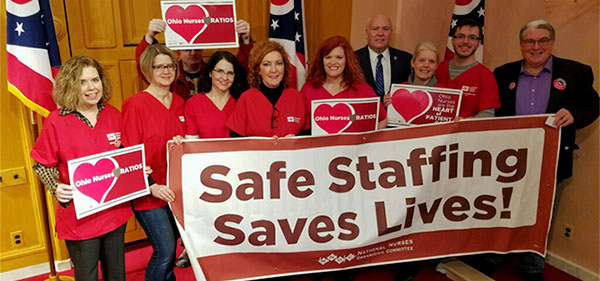Press Release
Ohio Bill Seeks Safety Limits on Number of Patients Assigned to RNs

Proposed Law Would Also Set Whistleblower Protection for Nurses
On Feb. 14, registered nurses with National Nurses Organizing Committee-Ohio/National Nurses United (NNOC/NNU) and elected officials will gather at the Ohio Statehouse, in Columbus, to mark the reintroduction by Senator Michael Skindell of the Ohio Patient Protection Act—a bill which sets specific limits on how many patients nurses can care for at once, in hospitals throughout Ohio.
“Studies have shown again and again that safe nurse-to-patient staffing ratios save lives,” said Rhonda Risner, RN, of the Dayton VA Medical Center in Dayton, Ohio. “We applaud Senator Skindell for standing up for Ohio patients, and we hope the Ohio senate will stand with us, to say that the people of Ohio deserve—with the passage of the Ohio Patient Protection Act—the kind of focused care that nurses can only provide when hospital corporations are held accountable for staffing at safe levels.”
The Ohio Patient Protection Act establishes minimum nurse-to-patient ratios for every hospital unit at all times (currently, there is no limit to the number of patients that nurses care for at any one time in Ohio hospitals). It also provides whistleblower protection to assure that nurses are free to speak out for enforcement of safe staffing standards. Skindell is joined on his bill, initially, by co-sponsor Senator Sandra Williams.
What: Nurses, Elected Officials Introduce Ohio Patient Protection Act
Where: Ohio Statehouse, 1 Capital Square, Columbus, OH 43215
When: Tuesday, Feb. 14, 11 a.m.
The bill is modeled on a California law that studies have documented has saved patient lives, improved the quality of care in multiple other ways, and reduced nurse burnout, keeping the most experienced RNs at the patient bedside.
“These policies will help ensure that patients get the best medical care based on need and will provide nurses with safeguards to ensure that they are protected from retaliation for whistleblowing and refusals to follow potential violations of the law,” said Senator Skindell. “Genuine and enforceable safe-staffing standards will save money and lives by ensuring that patients obtain excellent nursing care.”
“With no limit on the number of patients we care for, we have a safety crisis on our hands in Ohio; hospital administrators are free to cut corners on staffing and put their bottom line over patient safety,” said Debra McKinney, RN, of Affinity Medical Center in Massillon. “We need a mandatory, non-negotiable limit to the number of patients each nurse cares for in order to protect our patients from harm—and also to protect nurses and other healthcare staff.”
Decades of studies document link between improved RN staffing and safer care:
A 2016 study (Aiken et. al) collected data from 13, 077 nurses in 243 hospitals in six countries—and 18,828 patients in 182 of the same hospitals. The study found that with each 10 percentage point reduction in the proportion of professional nurses, there was an 11 percent increase in the odds of patient death.
A 2015 study in the Journal of Advanced Nursing also found that preventing understaffing was critical in improving the quality of care for hospitalized patients—highlighting the cost savings of safe staffing to the hospital, patients and the community, given that adverse events were estimated to increase costs by $8000 per admission and lengthen the stay by seven to eight days on average.
And California hospitals, which have had safe staffing laws in place since January, 2004 have shown that limiting the number of patients assigned to nurses saves lives. A 2013 study in the International Archives of Occupational and Environmental Health showed that the California safe staffing law was associated with 55.57 fewer occupational injuries and illnesses per 10,000 RNs per year, a value 31.6 % lower than the expected rate without the law.
National Nurses Organizing Committee-Ohio is part of National Nurses United, the largest union of registered nurses in the country, representing over 150,000 RNs nationwide.